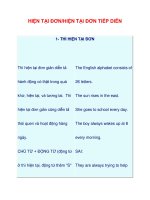HIỆN TẠI ĐƠN/HIỆN TẠI ĐƠN TIẾP DIỄN pps
Bạn đang xem bản rút gọn của tài liệu. Xem và tải ngay bản đầy đủ của tài liệu tại đây (145.61 KB, 15 trang )
HIỆN TẠI ĐƠN/HIỆN TẠI ĐƠN TIẾP DIỄN
1
-
THÌ HI
ỆN TẠI
Ð
ƠN
Thì hiện tại đơn giản diễn tả
hành động có thật trong quá
khứ, hiện tại, và tương lai. Thì
hiện tại đơn giản cũng diễn tả
thói quen và hoạt động hàng
ngày.
CHỦ TỪ + ÐỘNG TỪ (động từ
ở thì hiện tại, động từ thêm "S"
The English alphabet consists
of
26 letters.
The sun rises in the east.
She goes to school every day.
The boy always wakes up at 8
every morning.
SAI:
They are always trying to help
hay "ES" nếu chủ từ là ngôi 3 s
ố
ít: She, he, it, Mary, John)
Thì hiện tại đơn gi
ản có thể diễn
tả thời gian trong tương lai khi ý
nghĩ đó thuộc về thời khóa
biểu.
him.
We are studying every day.
ÐÚNG:
They always try to help him.
We study every day.
The game starts in ten minutes.
My class finishes next month.
Cụm từ và từ ngữ chỉ thời gian: Always, usually, often,
sometimes etc., (a fact, habit, or repeated action), every time, as
a rule, every day (every other day), once (a month), once in a
while
THÌ HI
ỆN TẠI TIẾP DIỄN
Thì hiện tại tiếp diễn diễn tả
hành động đang xảy ra.
CHỦ TỪ + IS/ARE/AM + ÐỘNG
TỪ THÊM -ING
Một hành động gì đó đang xảy
ra tuần này, tháng này, hoặc
năm này.
I'm typing right now.
It is raining at the moment.
Shhh! The baby is sleeping.
She is taking ESL 107 this
semester.
Tammy is writing a letter to her
mom tomorrow.
Thì hiện tại tiếp diễn có thể diễn
tả thời gian trong tương lai khi ý
nghĩ đó là 1 sự định sẵn.
Jack is visiting his relatives
tomorrow.
SAI: It is raining tomorrow.
(Rain không thể là 1 sự dự định
trước
Cụm và từ ngữ chỉ thời gian: Right now, at the moment, at
present, now, shhh!, listen!, look!, this semester.
SIMPLE PRESENT
Tóm tắt:
Present simple để chỉ:
1) Sự việc xảy ra trong hiện tại
2) Những sự thật hiển nhiên, sự việc lập đi lập lại hằng ngày: Thí
dụ: Trái đất quay xung quanh mặt trời.
Hằng ngày tôi thức dậy lúc 7 giờ sáng
3) Những động từ không ảnh hưởng đến thời gian: động từ tĩnh
(static verbs)
To belong to, to cost, to know, to believe, to like,
to love, to mean, to see, to understand
I (dis)like / love / hate / want that girl
I believe / suppose / think you’re right
I hear / see / feel the world around us
It tastes / smells good
4) Sau những liên từ WHEN, AS SOON AS
5) THỂ NGHI VẤN:
Thêm đằng trước DO hay DOES (ngôi thứ 3 số ít)
6) THỂ PHỦ ÐỊNH:
thêm DON'T , DOESN'T
__________________
The simple present is used to express actions which take place in
the present or which occur regularly (Things that happen
repetedly) .
It also serves to express general or absolute statements not
anchored in a particular time frame (Things in general)
I work at home.
The earth revolves around the sun
Politics are a dirty business.
Jill speaks four languages fluently.
I get up at seven o’clock every morning
Mrs. Smith teaches English at my school
On Sundays, we like to fish.
INTERROGATIVE FORM
In the interrogative, the present is generally introduced by a form
of the verb "to do" ("do / does" :
Does your father like to cook?
Do you have time to stop by my place?
NEGATIVE FORM
The appropriate form of the verb "to do" will also be used for the
negative:
I do not (don't) work at home.
No, he does not (doesn't) like to cook.
AFTER WHEN AS SOON AS
After the conjunctions "when," "as soon as," etc., the present is
used, even though actions expressed may refer to the future:
She'll come when she can.
He'll pay us as soon as we finish.
Forming the simple present
The present is extremely regular in its conjugation. As a
general rule, one uses the base form of the infinitive (minus
the preposition "to" .
For the third person singular ("he," "she," "it" , an "-s" is
added if the verb ends in a consonant,
or "-es" if the verb ends with a vowel:
To work
I work
you work
he / she / it works
we work
they work
To go
I go
you go
he / she / it goes
we go
they go
However:
verbs ending with "consonant + y" (for example, "to try," "to
cry," "to bury," etc.) will end in "-ies" in the third person
singular:
To bury
I bury
you bury
he / she buries
we bury
they bury
"To have", "to be"
The only irregular verbs in the present are "to have," "to be,"
and the modal verbs.
To have
I have
you have
he / she has
we have
they have
To be
I am
you are
he / she is
we are
they are









